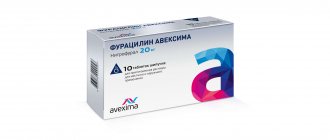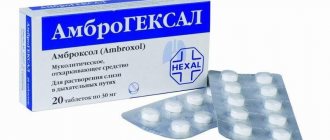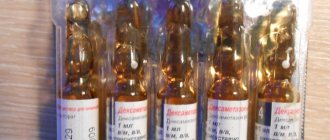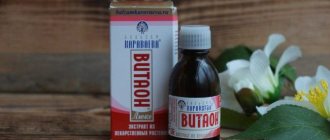Pharmacodynamics and pharmacokinetics
about dimethyl sulfoxide , what it is and exactly how it works, to understand the effect of the drug. This product is abbreviated as DMSO . It is a colorless liquid that is a bipolar aprotic solvent.
The active ingredient of the drug Dimethyl sulfoxide penetrates biological membranes. It has anti-inflammatory , antiseptic , analgesic and fibrinolytic effects. It has a transporting ability, which manifests itself through increased penetration of drugs through the skin and mucous membranes.
The mechanism of action of this drug is revealed through the inactivation of hydroxyl radicals. It helps in improving metabolism at the site of inflammation, and also reduces the speed of excitatory impulses in peripheral neurons .
When dimethyl sulfoxide it is detected in the blood after about 5 minutes. The maximum concentration of the active component is recorded after approximately 4-6 hours. At the same time, it remains at an almost unchanged level for 1.5-3 days. is metabolized to some extent in the liver. Excreted in urine and feces.
Dimethyl sulfoxide
International name of the medicinal substance:
Dimethyl sulfoxide The list of drugs containing the active substance Dimethyl sulfoxide is given after the description.
Pharmacological action:
Anti-inflammatory drug for external use, inactivates hydroxyl radicals, improves the course of metabolic processes in the site of inflammation. It also has local anesthetic, analgesic and antimicrobial effects; has moderate fibrinolytic activity. Penetrates through the skin, mucous membranes, the membrane of microbial cells (increases their sensitivity to antibiotics) and other biological membranes, increases their permeability to drugs.
Indications:
As part of complex therapy: diseases of the musculoskeletal system: rheumatoid arthritis, ankylosing spondylitis (Bechterew's disease), deforming osteoarthritis (in the presence of damage to periarticular tissues), reactive synovitis;
limited scleroderma, erythema nodosum, discoid lupus erythematosus, mycoses of the feet, keloid scars, thrombophlebitis, alopecia, eczema, erysipelas; bruises, sprains, traumatic infiltrates; purulent wounds, burns, radiculitis, trophic ulcers, acne, furunculosis, in skin-plastic surgery - preservation of skin homografts. Contraindications:
Hypersensitivity, severe hepatic and/or renal failure, angina pectoris, severe atherosclerosis, glaucoma, cataracts, stroke, coma, myocardial infarction, pregnancy, lactation.
Side effects:
Allergic reactions, contact dermatitis, erythematous rashes, dry skin, mild burning, itchy dermatitis;
rarely - bronchospasm. Interaction:
Increases absorption and enhances the effect of ethanol, insulin and other drugs.
Compatible with heparin, antibacterial drugs, NSAIDs. Increases the sensitivity of microorganisms to aminoglycoside and beta-lactam antibiotics; chloramphenicol, rifampicin, griseofulvin. Sensitizes the body to drugs for general anesthesia. Special instructions:
Some patients smell garlic in the air they breathe.
Before using the drug, it is necessary to test for tolerance to it. To do this, dimethyl sulfoxide is applied to the skin using a cotton swab soaked in it; the appearance of hyperemia and severe itching indicates hypersensitivity. Preparations containing the active ingredient Dimethyl sulfoxide:
Dimexide
The information provided in this section is intended for medical and pharmaceutical professionals and should not be used for self-medication. The information is provided for informational purposes only and cannot be considered official.
Indications for use
Dimethyl sulfoxide is used in the case of inflammatory diseases of the musculoskeletal system, traumatic infiltrates , purulent wounds, osteomyelitis , streptoderma , bruises, inflammatory edema , abscesses , erythema nodosum .
In addition, it can be prescribed for combination with NSAIDs for the treatment of deforming osteoarthritis and rheumatoid arthritis , with Heparin in the case of thrombophlebitis , as well as with local antimicrobial scleroderma , erysipelas , eczema , acne , furunculosis , trophic ulcers . The product is also used in skin plastic surgery to preserve skin homografts
Mode of application
Before use, the product must be diluted with water 1:1. Externally used in the form of irrigations, applications, compresses, which are applied to problem areas in such a way that they capture a small part of healthy tissue.
For a compress, soak gauze sections with the solution and apply for half an hour once a day. The top of the fabric is covered with film and wrapped in woolen cloth. The course is two weeks.
The concentration of the drug is selected depending on the disease:
- trophic ulcers, erysipelas - 30-50%;
- eczema, streptoderma – 40-90%;
- deep burns – 20-30%;
- pustular diseases – 40%;
- skin plastic surgery – 20-30%;
Instructions for use of Dimethyl sulfoxide (Method and dosage)
The instructions for Dimethyl sulfoxide indicate that it is used, as a rule, in the form of aqueous solutions (approximately 50% concentration) for compresses, rinsing and tampons. Gauze is moistened with the solution and applied to the affected areas, as well as adjacent areas. Next, a plastic film and cotton or linen fabric are applied.
In the case of trophic ulcers and erysipelas, the medicine is used in the form of a solution (30-50%) 2-3 times a day in a dosage of 50-100 ml. Instructions for use for eczema and diffuse streptoderma recommend making compresses with a solution (40-90%). For furunculosis, a 40% solution is used. For local anesthesia, take a solution (25-50%) and make compresses 2-3 times a day in a dosage of 100-150 ml. In case of deep burns , apply bandages with a 20-30% solution. If it is necessary to wash purulent-necrotic wounds and areas of inflammation, a 10-30% solution is used.
Dimethyl sulfoxide solution 20-30% is also used in skin plastic surgery for auto- and homografts . Bandages are applied immediately after surgery and on the first day before the graft engrafts.
Additionally, a 5% solution in Ringer's solution is used as a preservation medium for skin homografts .
Dimethyl sulfoxide
Use as a solvent
DMSO is an important bipolar aprotic solvent. It is less toxic than other members of this group, such as dimethylformamide, dimethylacetamide, N-methyl-2-pyrrolidone, HMPTA. Due to its strong dissolving ability, DMSO is often used as a solvent in chemical reactions involving inorganic salts, in particular in nucleophilic substitution reactions. The acidic properties of DMSO are weak, so it has become an important solvent in the chemistry of carbon anions. Non-aqueous pKa values for hundreds of organic compounds have been measured in DMSO[1].
Due to its high boiling point, DMSO evaporates extremely slowly at normal atmospheric pressure. This makes it a very convenient solvent for reactions when heated. At the same time, the rather high melting point limits its use at low temperatures. After carrying out the reaction in DMSO solution, reaction mixtures are most often diluted with water to precipitate organic substances.
The deuterated form of DMSO, also known as DMSO-d6, is a convenient solvent for NMR spectroscopy due to its high solubility for a wide range of substances, the simplicity of its own spectrum, and its stability at high temperatures. The disadvantages of DMSO-d6 as a solvent for NMR spectroscopy are its high viscosity, which broadens the signals in the spectrum, and its high boiling point, which makes it difficult to reverse isolate the substance after analysis. Often DMSO-d6 is mixed with CDCl3 or CD2Cl2 to reduce viscosity and melting point.
DMSO is finding more and more applications in the production of microelectronics[2].
DMSO is a more effective and safer paint stain remover than gasoline or dichloromethane.
Along with nitromethane, DMSO is also a means of removing “super glue” (hardened but still fresh) and polyurethane foam.
Application in biology
DMSO is used in PCR to inhibit the pairing of parent DNA molecules. It is added to the PCR mixture before the start of the reaction, where it interacts with complementary sections of DNA, preventing their pairing and reducing the number of side processes[3].
DMSO is also used as a cryoprotectant. It is added to the cell medium to prevent cell damage during freezing[4]. Approximately 10% DMSO can be used to safely cool cells and also to store them at liquid nitrogen temperature.
Application in medicine
Main article: Dimexide
As a medicine, purified dimethyl sulfoxide is used in the form of aqueous solutions (10-50%), as a local anti-inflammatory and analgesic, and also as part of ointments to increase the transdermal transfer of active substances, since it penetrates the skin in a few seconds and transports other substances. The trade name of the drug is “Dimexide”.
Application in military affairs
| This section is missing references to information sources. Information must be verifiable, otherwise it may be questioned and deleted. You may edit this article to include links to authoritative sources. This mark was set on May 12, 2011 . |
Due to its ability to dramatically enhance transdermal transport, dimethyl sulfoxide has been considered a chemical weapon component. The goal was to achieve a high rate of penetration of agents into the body by mixing (especially those with a pronounced skin-resorptive effect) and dimethyl sulfoxide. Thus, one drop of a substance mixed with dimethyl sulfoxide (that is, a smaller dose) causes the death of an experimental animal twice as fast as the same drop of pure chemical agent. (Dick Francis' detective story "Preliminary Arrival" describes the formulation of a toxic composition that penetrates the skin, one of the components of which is dimethyl sulfoxide.)
The use of "Dimexide" in cosmetology
The solution and ointment are widely used to preserve the beauty and youth of the skin and hair. At the same time, many people have a question: how to dilute the Dimexide solution? The instructions for use warn that to prevent the development of burns and allergic reactions, it is worth diluting 100% of the substance with water for injection or distilled liquid in a ratio of 1 to 20.
That is, for one part of dimethyl sulfoxide there should be 20 parts of neutral liquid.
Depending on the purpose of use, the following ingredients are usually added to a hair mask:
- burdock, castor, olive oils;
- egg yolk, kefir;
- natural mayonnaise;
- quail eggs;
- coconut milk.
Such natural masks do not last long - no more than a day, so they must be used immediately after preparation.
To rejuvenate facial skin and get rid of wrinkles, use the following recipe:
- 1 teaspoon “Solcoseryl”;
- 1 teaspoon of Dimexide solution;
- a teaspoon of olive oil;
- a teaspoon of freshly squeezed aloe juice.
Mix all components until smooth. Apply a thin layer to the face and wash off after half an hour. The mask has a rejuvenating effect, refreshes and nourishes the skin.
Reviews about the use of “Dimexide” in cosmetology are enthusiastic: the mask helped hundreds of women look visually younger, and they began to enjoy their reflection in the mirror.
Pharmacological properties
Pharmacodynamics
Dimethyl sulfoxide is an anti-inflammatory, analgesic, antimicrobial agent. Dimethyl sulfoxide penetrates well through biological membranes, including the skin, mucous membranes, and the membrane of microbial cells (increases their sensitivity to antibiotics), facilitating the penetration of drugs through the skin and mucous membranes. Shows pronounced local analgesic activity for pain syndromes of various etiologies, has anti-inflammatory, antimicrobial and fibrinolytic effects, changes the sensitivity of microflora resistant to antibiotics. It also performs a transport function, ensuring deep penetration of other drugs through the skin and mucous membranes.
Pharmacokinetics
When applied to the skin and mucous membranes, it is quickly and almost completely absorbed. Dimethyl sulfoxide is detected in the blood serum 5 minutes after application to the skin, the maximum concentration is reached after 4-6 hours and remains almost unchanged for 1.5-3 days. Penetrates well into tissue cells of all organs, with the exception of hair, nails and tooth enamel. Metabolized by oxidation to methylsulfonylmethane, followed by reduction to dimethyl sulfide. Dimethyl sulfoxide metabolites are excreted in urine and feces, and can also be excreted through the skin and lungs, which is accompanied by a specific garlic odor. Accumulation of dimethyl sulfoxide and its metabolites in the body does not occur with long-term use.








